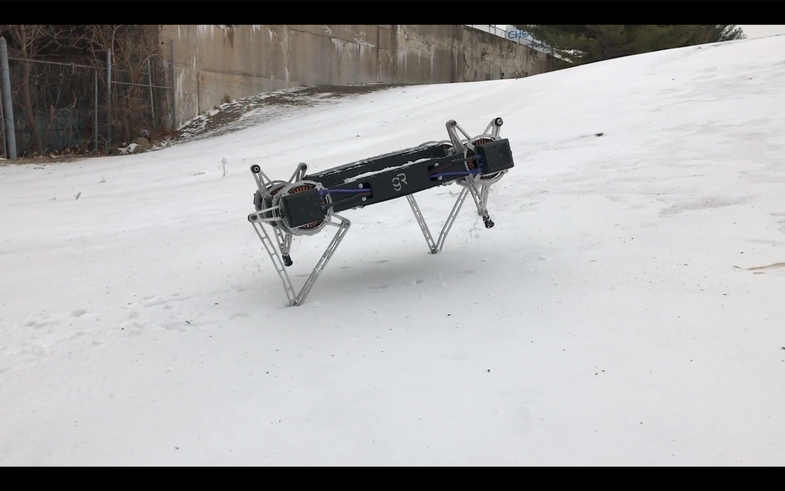A new legged robot wants to wobble, crawl, and bounce its way into the market
Minitaur wants to get a leg up on wheeled robots

It was sand that killed Spirit. In May 2009, after years spent traversing the Martian surface, NASA’s Spirit rover got stuck in a sand trap. And, for the last two years of its mission life, it remained stuck, wheels powerless against the loose, light sand. All vehicles sent to Mars so far are wheeled. But what if there was another way to explore a distant world?
“With a wheeled robot, you can try and go forward, or you can try and go backward, and that’s about all the affordance you have trying to get out of a bind like that,” says Gavin Kenneally, one of the cofounders of Ghost Robotics. We are talking today about the Ghost Robotics Minitaur, a legged robot that first made waves last year with its ability to climb fences and jump to open doors.
“With a legged machine,” Gavin continues, “there’s a lot of difficulty coordinating all the degrees of freedom. That’s why we haven’t seen as many legged robots in the market until now. Once you have the coordination problem down, you have so many ways of getting yourself out of these, you’re not going to get stuck trying to go backward and trying to go forward. You really have lots of options.”
Mars is my own hypothetical here. There are no talks to send the robot anywhere besides Earth, and extraterrestrial exploration is another set of hurdles well beyond where the design is now. Still, it’s hard to watch it scramble over rocks and not think about movement in alien worlds.
For their part, Ghost Robotics’ ambitions are focused very much on concerns at earth.
“We’re looking at the UGV market—the unmanned ground vehicle marketplace—micro-to-small, small-to-medium sized robots. The payloads we’re looking at are typically sensor payloads. We’re looking at it as a mobile sensor platform, just to kind of give you a precursor to details on the platform,” says Jiren Parikh, the CEO of Ghost Robotics.
The company is quick to draw the distinction between their legged robots and the larger, more famous legged robots of Boston Dynamics. The design of Minitaur is roughly 16 inches hip to hip, and it can be scaled down to about half that. The smallest Boston Dynamics robots are much larger, and their primary tasks are carrying stuff for humans. Minitaur, instead, wants to carry sensors, like cameras, and go where people can’t easily go, like under cars.
The military applications are almost self-explanatory. A little robot that could sweep under vehicles for signs of obvious tampering or explosives is probably worth bringing along. That’s the first market Ghost Robotics aims to enter: as a scout and sensor for the military, one that can go where tracked and wheeled robots can’t. According to Ghost Robotics, the Army Research Lab is already testing a few of the Minitaur robots.
Battlefields aren’t the only place we might see these strange legged machines.
“A second area is search and rescue,” says Parikh, noting that an urban earthquake means a complicated mix of terrain that’s ideal for legs, not wheels. “It’s got a number of compelling applications for finding living humans.”
Beyond military and rescue work, Ghost Robotics wants to see their legged machine bumbled alongside scientists and researchers far from roads and pavement, or helping industry in mining and oil field exploration. Perhaps there’s even a role for it in the melting arctic.
That’s where the Minitaur is aimed for now, and the company hopes to have a rugged, waterproofed version on the market in the next couple of years. Once on the market, where could such a robot ultimately go? The answer might be much closer to home than the stars above.
“It seems like it’s not gonna be too long before robots have a much more intimate roles in our lives and are really helping us to be really capable tools and assistants,” says Avik De, Ghost Robotics co-founder. “It’s pretty obvious to us that there’s so many obstacles to wheels and tracks, we’ll get beyond that with legs you can move around the built environment and go anywhere humans can potentially go and dangerous settings where humans don’t want to go.”
Watch Minitaur in action below:
